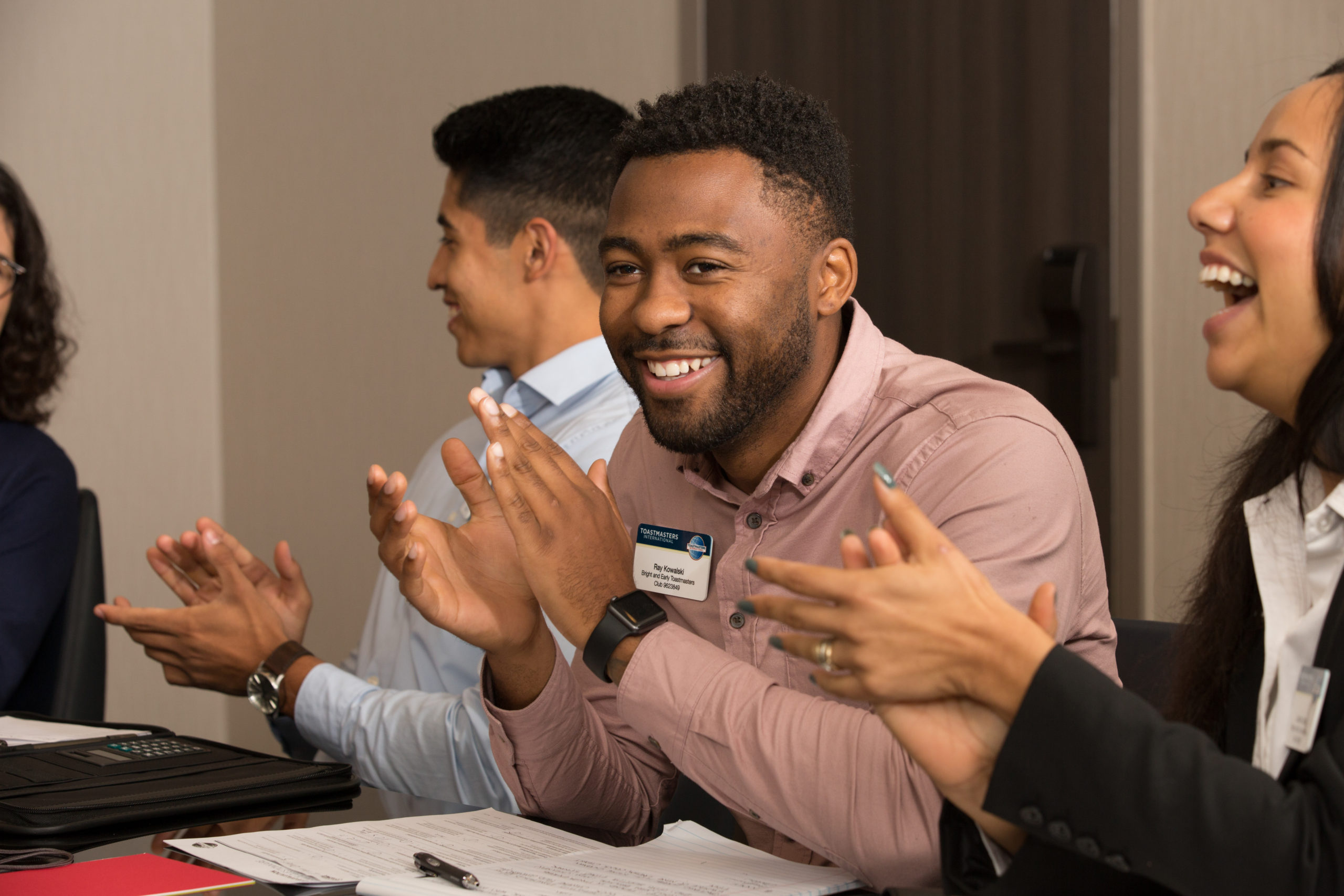Club Meeting Roles
Do you want to learn how to do your club meeting role? Here is a summary of typical roles that you’ll find at a Toastmaster club.
Toastmaster
Responsible for Running the Meeting
The main duty of the Toastmaster is to act as the host/MC and conduct the entire program, including introducing participants. If the Toastmaster does not perform the duties well, the entire meeting suffers. For obvious reasons this task is not usually assigned to a member until he or she is quite familiar with the club and its procedures. Program participants should be introduced in a way that excites the audience and motivates them to listen. The Toastmaster creates an atmosphere of interest, expectation, and receptivity.
Prior to the Meeting
- Check with the VPE to find out if a special theme has been set for the meeting and if there are any program changes. If no theme has been chosen – then you are free to do this.
- Ensure that you review the role purpose and duties.
- Prepare introductions for each speaker. A proper introduction is important to the success of the speaker’s presentation.
- Prepare remarks which can be used to bridge the gaps between program segments. You may never use them, but you should be prepared to avoid possibly awkward periods of silence.
- Remember that performing as Toastmaster is one of the most valuable experiences in your club work. The assignment requires careful preparation in order to have a smoothly run meeting.
Upon arrival at the Meeting
- Check with the VPE and speakers for any last minute changes.
- Sit near the front of the room.
- Pass your Competent Leader manual to a fellow Toastmaster for evaluation.
During the Meeting
- Assume control of the meeting from the President.
- Explain the role of the Toastmaster to the room.
- Conduct the round robin. Your question needs to be something that people can answer in 15-20 seconds, and something relating to the theme.
- Preside with sincerity, energy, and decisiveness.
- Always lead the applause before and after each speaker.
- Remind all segment leaders to explain the purpose of the segment and the timing.
- Introduce each meeting segment leader and speaker in turn. The introduction of a speaker should be “Speaker Name” “Title of Speech” “Title of Speech” “Speaker Name”.
- After making your introduction, remain at the lectern until the speaker has shaken your hand; then be seated.
- Return control of the meeting back to the President at the end.


Grammarian
Notices the use of English During the Meeting
Another purpose of Toastmasters is to help people improve their grammar, pronunciation and use of words. Your responsibility is to comment on the use of English during the course of the meeting.
Prior to the Meeting
- The role involves creating a word of the night. Print out the word in large letters
Upon arrival at the Meeting
- Get a pen and blank piece of paper on which to make notes.
- Pass your Competent Leader manual to a fellow Toastmaster for evaluation.
During the Meeting
- Explain the role of the Grammarian.
- Tell everyone the word of the night. Give its definition and a couple of examples of its usage. Place one copy on the board, and another in the front row of seats can both the audience and speakers can see it.
- Listen to everyone’s word usage and language, grammar etc.
- Write down any misuse of language or creative language use. At the end of the night, deliver a report where you tell people who/and how many times the WOTD was used.
- Report on any creative language. If there are any misused words, offer the correct usage rather than only explaining what was wrong.
Speaker
Presents a Prepared Speech to the Audience
The major portion of each meeting is centred around three or more speakers. Their speeches are prepared based on manual project objectives and should last from five to seven minutes for projects in the Competent Communication manual and eight or more minutes (depending on the assignment) for projects in the Advanced Communication manuals. Preparation is essential to success when you are the speaker.
Every speech should be well prepared and rehearsed to ensure quality. When speakers prepare their speeches at the last minute, their minimal effort is readily apparent to everyone. Remember that club members learn from one another’s speeches. Every speaker is a role model.
Prior to the Meeting
- In order to get the most benefits from the program, prepare a speech based on a manual project. Present the speeches in numerical order because each project builds on the skills learned in previous projects.
- Check the meeting schedule to find out who your evaluator is. Speak to him/her and talk about the project you will be delivering. Discuss with the evaluator your speech goals and personal concerns. Emphasize where you feel your speech ability needs strengthening.
Upon arrival at the Meeting
- Pass your Competent Communication manual to your evaluator for the written evaluation.
- Ensure the Toastmaster knows the title of your speech.
- If you want a particular speech introduction, write it down and give to the Toastmaster – along with any other special requests i.e. projector, table set up etc.
During the Meeting
- When called upon by the Toastmaster, be waiting at the side of the stage and walk up to the lectern, ready to present your prepared speech.
- Watch the timing of the lights and try to keep within the specified time limit for the project you are delivering.
- Return control of the meeting to the Toastmaster once finished.


Table Topics Master
Presents Engaging Questions to Improve Impromptu Speaking Skills
Table Topics provides those members not assigned a meeting role an opportunity to speak during the meeting. The purpose is to have members improve their impromptu speaking. The Table Topics master prepares topics/questions (usually in line with the theme of the meeting) and gives each member a subject, and the speaker gives a 60-90 second impromptu talk on the subject; originality is desirable as much as possible.
Prior to the Meeting
- If there is a meeting theme, prepare topics related to that theme. If no theme is scheduled, choose your own theme or topics. Review The Toastmaster magazine, newspapers and other publications for ideas.
- Do not repeat the previous week table topics ideas or items.
- Make a list of potential names to whom you can ask your questions. People undertaking the roles of Toastmaster, Speaker, Evaluators and General Evaluator should NOT be asked a Table Topic unless not enough other people are present at the meeting.
- When choosing your specific questions:
- Select ones that will enable the speakers to expand on them, give their opinions, etc.
- Don’t make the questions too long or complicated.
- Make 3 copies of the question list (one each for the TT evaluators).
Upon arrival at the Meeting
- Pass your Competent Leader manual to a fellow Toastmaster for evaluation.
During the Meeting
- Explain the role of the Table Topics master. Mention the speaking times and that guests may pass if they wish.
- Call on speakers at random. Avoid going around the room in the order in which they are sitting.
- Give each participant a different question.
- Whilst the goal is to ask as many questions as possible during Table Topics – please always keep a note of the time. If the meeting is running over, then you will need to ask fewer questions.
Other suggested Table Topic Formats
- Use quotes from a desk calendar.
- Gripe session – ask people their pet peeve about a specific topic.
- Give a member a picture to describe. He/She is not allowed to name the object. Members have to guess what the object is.
- Use objects, pictures or headlines from the paper and ask people about them.
- Have a mystery bag filled with random objects that the speaker needs to describe/sell/use without actually mentioning the object.
Speech Evaluator
Give Feedback about the Speaker's Speech
After every prepared speech, the speaker receives an evaluation. After you have presented a few speeches, you will be asked to serve as an evaluator and will evaluate one of the prepared speakers for the meeting. In addition to your oral evaluation, you also will give the speaker a written evaluation using the guide in the manual. The purpose of the evaluation is to help the speaker become less self-conscious and a better speaker.
Prior to the Meeting
- Prepare carefully. The purpose of an evaluation is to help people develop their speaking skills. By actively listening and gently offering useful advice, you motivate members to work hard and improve.
Upon arrival at the Meeting
- Look for the speaker and get his or her manual.
- Confer with the speaker to see if he/she has any specific things for you to watch for during the speech.
- Pass your Competent Leader manual to a fellow Toastmaster for evaluation.
During the Meeting
- You will be asked to read the objectives of the speech by the Toastmaster. There is no need to read out the title as the Toastmaster will do this when introducing the speaker.
- Record your impressions of the speech in the manual along with your answers to the evaluation questions. Be as objective as possible. Good evaluations may give new life to discouraged members and poor evaluations may dishearten members who tried their best. Always leave the speaker with specific methods for improving.
- The format of the verbal evaluation should follow the Praise Improvement Praise (PIP) method. That is:
- Start with one or two points of praise.
- Then make one or two suggestions for improvement with examples of the benefit of applying the suggestion. E.g. ‘I think Dan can work on his volume. He can do this by taking deeper breaths and projecting to the back of the room. The benefit of doing this is that everyone will hear every word he says.’
- Follow up with one or two more points of praise.
- Finally, summarise briefly with no new information, recapping the PIP points.


Table Topics Evaluator
Give Feedback about the Table Topics Speakers' Speeches
Every segment of the meeting is evaluated including Table Topics.
Prior to the Meeting
- Depending on the format of the session, you may use any or a combination of the following upon which to write your evaluation: a blank sheet of paper or the question list provided by the Table Topics Master.
Upon arrival at the Meeting
- Obtain the list of questions from the Table Topics Master.
- Pass your Competent Leader manual to a fellow Toastmaster for evaluation.
During the Meeting
- Explain the role of Table Topics evaluator. Make notes on each Table Topics speaker looking for such things as:
- Their opening
- Was the question answered?
- Did they use humour or personal anecdotes?
- The usual evaluation points, such as – gestures, use of hands, body language, stage presence.
- Each evaluation must contain a point of praise, a point of improvement and then completed with a point of praise.
Ah Counter
Identify Filler Words
The purpose of the Ah Counter is to note words and sounds used as “filler words” by anyone who speaks during the meeting. Examples of filler words are “and, well, but, so, you know, like”; sounds may be “ah, um, er”. These words and sounds can be annoying to listeners and are often used instead of pausing.
Prior to the Meeting
- Ensure that you have a pen and blank piece of paper on which to make notes.
Upon arrival at the Meeting
- Pass your Competent Leader manual to a fellow Toastmaster for evaluation.
During the Meeting
- Throughout the meeting, listen to everyone for filler words or sounds and count them for each person.
- When called upon by the Toastmaster to report:
- Explain the role of the AH Counter.
- The report should be brief i.e. Natalie 5, Sarah 6, Cleo 3.


Timer
Keep the Meeting On Time
One of the skills to be practised in speech training is that of keeping to time. The timer is the member responsible for keeping track of time. Each segment of the meeting and each speaker in it is timed.
Prior to the Meeting
- Check the scheduled program to ensure familiarity with the plan.
- Get a blank piece of paper and pen ready on which to make notes.
Upon arrival at the Meeting
- Sit in the seat where the timing lights are set up. Be sure you understand how to operate the stopwatch and lights and make certain that the timing equipment works. You should also have backup timing cards (green, orange and red) ready for emergencies.
- If there is an educational scheduled, check with the presenter as to when he/she wishes the timing signals to be given.
- Pass your Competent Leader manual to a fellow Toastmaster for evaluation.
During the Meeting
- Throughout the meeting, time each program participant and signal. All segments use the timing lights. The timing lights are used as follows:
- The timing device is turned to green and left on.
- Then the timing device is switched to orange, and left on.
- Then the timer is turned to red, and left on until the speaker finishes.
- In the round-robin, strictly keep each speaker to the allocated time (usually 15-30 seconds). If you have a noise-making device, activate it to warn the speaker.
- When introduced by the Toastmaster to give the report:
- Read the report. The main parts that should be reported on are:
- The round robin.
- The speaker’s times, by stating the person’s name and time taken.
- All evaluators and table topics speakers.
- The report should be brief.
- These are average times used for presentations:
| Activity | Green | Orange | Red |
| Round Robin | 15 seconds | 20 seconds | |
| Table Topics Participants | 1 min | 1 min 15 sec | 1 min 30 sec |
| Table Topics Evaluators | 2 min | 2 min 30 sec | 3 min |
| Speeches | 5 min | 6 min | 7 min |
| Evaluators | 2 min | 2 min 30 sec | 3 min |
| General Evaluator | 3 min | 4 min | 5 min |
General Evaluator
Give Feedback on the Meeting and the Supporting Roles
At Toastmasters, everything is evaluated. The role of the general evaluator is to evaluate all those who have not yet been evaluated i.e. Toastmaster, Grammarian, Table Topics Master, Table Topics Evaluator and Speech Evaluators.
Prior to the Meeting
- Check with the VPE to find out if there are any planned deviations from the usual meeting format.
Upon arrival at the Meeting
- Sit near the back of the room to allow yourself full view of the meeting and its participants.
- Pass your Competent Leader manual to a fellow Toastmaster for evaluation.
During the Meeting
- Take notes on everything that happens (or doesn’t but should). For example: Is the Club’s property (trophies, banner, educational material, etc.) properly displayed? If not, why? Were there unnecessary distractions that could have been avoided? Create a checklist from which you can follow the meeting. Did the meeting, and each segment of it, begin and end on time?
- Make notes on the following: Toastmaster, Table Topics Master, Table Topics Evaluators, Speech Evaluators. If you have time, then you can give feedback to the other segment leaders however, you only have 5 minutes in total. Do not re-evaluate the speakers.
During the Meeting
- Explain your role as General Evaluator.
- When introduced to conduct the General Evaluation, go to the lectern and deliver your evaluation of the meeting, using the notes you took as suggested above.
- Give feedback to the evaluators. If they did not give the speaker a point of improvement, you may suggest one they could have given.
- A simple and effective way to provide the feedback is to start from the top of the agenda i.e. SAA and work your way down – Toastmaster, Grammarian, Table Topics Master, Speech Evaluators etc etc


Table Topics Evaluator
Give Feedback about the Table Topics Speakers' Speeches
Every segment of the meeting is evaluated including Table Topics.
Prior to the Meeting
- Depending on the format of the session, you may use any or a combination of the following upon which to write your evaluation: a blank sheet of paper or the question list provided by the Table Topics Master.
Upon arrival at the Meeting
- Obtain the list of questions from the Table Topics Master.
- Pass your Competent Leader manual to a fellow Toastmaster for evaluation.
During the Meeting
- Explain the role of Table Topics evaluator. Make notes on each Table Topics speaker looking for such things as:
- Their opening
- Was the question answered?
- Did they use humour or personal anecdotes?
- The usual evaluation points, such as – gestures, use of hands, body language, stage presence.
- Each evaluation must contain a point of praise, a point of improvement and then completed with a point of praise.
